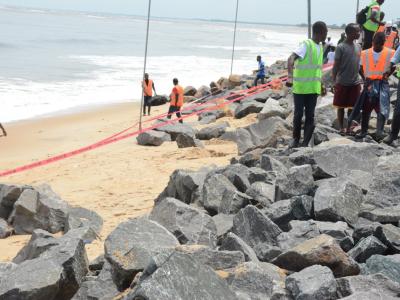
The United Nations Development Programme is working with the Government of Liberia to ensure investment of a new tranche of US$4 million from the Least Developed Countries Fund is used to reduce the vulnerability of physical assets and natural systems, protect coastal areas, and mitigate carbon dioxide emissions. The "Enhancing Resilience Of Liberia Montserrado County Vulnerable Coastal Areas To Climate Change Risks II" project will work to build national capacity and drive policy coordination in the coastal county of Montserrado to plan and respond to climate change. The project will benefit from a proposed US$2.2 million Global Environment Facility Least Developed Countries Fund grant and US$2.1 million in co-financing.
The project will contribute to global environmental benefits and improve the livelihoods of the citizens of Liberia with the improved management of 300 million hectares of seascapes, placing 120 million hectares under sustainable land management practices. It will promote the collective management of transboundary water systems, and implement a full range of policy, legal and institutional reforms and investments to contribute to the sustainable use of ecosystem services.
Large environmental benefits are also planned. Most notably, 750 million tons of Carbon Dioxide will be mitigated and 1000 tons of mercury will be reduced.
- District
- Local Governments
- Global Environment Facility (GEF)
Expected outcomes
Outcome 1 – Vulnerability of physical assets and natural systems reduced.
Outcome 2 – At the sites of Hotel Africa and Kru Town, sustainable and affordable measures to protect coastal areas against climate change impacts are demonstrated.
The Liberia coastline is subject to see level rise. Indeed, by the year 2090, the SRESB1 predicts a rise of sea level between 0.13m and 0.43m, whereas SRESA1 predicts a rise of between 0.18m and 0.56m , relative to 1980 - 1999 mean , (INC, 2013). This forecasted sea level rise, combined with increased intensity of storms and potential storm surges is very likely to accelerate the present catastrophic situation of coastal erosion. The orientation of Liberia’s coastline and its location on the Gulf of Guinea coastline, make it particularly exposed to the southern Atlantic annual sea storm surges. These surges lead to average tidal rises of over 2m during a brief period in spring – a major driver of coastal erosion. According to the NAPA (2008), the areas along the coast where erosion is most severe are Montserrado County coastlines, (West Point and New Kru Town and River Cess), Buchanan and Cestos Cities.
In the Montserrado County, sea-level rise would lead to shoreline retreat. The intensity of the retreat would vary along the coast from between 10 meters/year in the higher cliffed zone (e.g. between Mamba Point and Sinkor) to about 20 meters/year in the lowlands on Bush Rod Island. A considerable population is currently residing and working in these threatened zones, particularly around West Point. Another important expected impact of sea level rise is direct inundation of low-lying wetlands and dry land areas. For example, over the last 40 years, Liberia has experienced a number of climate-induced and sea-induced disasters. Communities such as New Kru Town and Hotel Africa in Montserrado are regularly under water. According to the Environment Protection Agency (EPA), it is projected that a one meter sea level rise (scenario B2) would lead to permanent inundation of about 95 km2 of land in the coastal zone of Liberia. With a one-meter sea level rise, densely populated parts of t he capital city of Monrovia and its environs – including West Point, Hotel Africa, Kru Town and River Cess would be submerged. These are currently the housing areas for tens of thousands of people. A conservative estimate suggests about 250 million United States Dollars worth of land and infrastructures (such as the Hotel Africa complex) would be lost . The anticipated socio-economic impacts of the nexus of sea-level rise, coastal erosion and regular coastal flooding are largely negative and potentially disastrous for coastal communities. These factors are likely to have most impacts in the most densely populated areas such as the coastal areas of the County of Montserrado with large numbers of poor people. They are likely to destroy property, destroy rural infrastructure (markets, roads, centres, clinics), to destroy land, to destroy livelihood equipment (boats, mobile market stands, stoves, etc). Quite simply, the poor people have nowhere to go and no way to protect their personal and community belongings. Montserrado coastal communities are already observing and feeling the impacts of the sea-level rise, coastal erosion and coastal flooding nexus.
Output 1 – Capacity of the climate change secretariat enhanced to drive policy coordination in the coastal county of Montserrado to plan and respond to climate change.
Expected Outputs:
• 1.1. Raised awareness of senior county officials, decision-makers and stakeholders.
• 1.2 Capacity of the National Climate Change Secretariat (NCCS) is strengthened
• 1.3 A county coastal protection unit is established, staffed and equipped
• 1.4 Semi-skilled workers able to prepare, build and maintain gabions and revetments etc.
• 1.5 A system for monitoring the maintenance of coastal protection measures is established,
• 1.6 County Development Agenda that fully addresses climate change prepared and approved.
Outcome 2 – At the sites of Hotel Africa and Kru Town, sustainable and affordable measures to protect coastal areas against climate change impacts are demonstrated.
Expected Outputs:
• 2.3 Hotel Africa and New Kru Town communities protected from climate change impacts.

